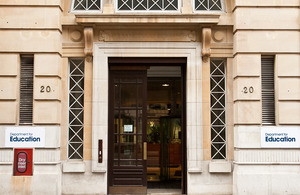Twice as many students now taking key academic subjects thanks to the EBacc
Information on the success of the English Baccalaureate.

- Long-term decline reversed.
- Poorer pupils benefiting most.
Figures out today reveal how the introduction of the English Baccalaureate has led to a huge increase in the proportion of young people studying the core academic subjects so highly valued by universities and employers.
The EBacc was introduced by the Department for Education in the performance tables in January 2011. Pupils who achieve a GCSE grade C or better in English, maths, a language, history or geography, and two sciences achieve the EBacc.
In 2010 under a quarter (22 per cent) of GCSE pupils were entered for the EBacc.
But a survey of more than 600 teachers in state-maintained mainstream secondary schools by Ipsos Mori for the Department for Education today reveals that almost half (49%) of Year 9 pupils have chosen to study the set of key subjects from this September.
The take-up indicates that the EBacc is reversing the long-term and damaging drift away from the subjects most likely to lead to higher education and good jobs, and that they are bouncing back to the levels of a decade ago.
Table 1: Proportion of pupils taking EBacc subjects
| Subject | Proportion of pupils who took GCSEs in summer 2010 (subject entries) (%) | Proportion of pupils taking GCSEs in summer 2014 (subject choices) (%) | 2010-14 change (% pts) | Percentage increase in proportion of pupils studying the subject 2010-2014 (%) |
| EBacc combination | 22 | 49 | +27 | 123 |
| History | 31 | 41 | +10 | 32 |
| Geography | 26 | 36 | +10 | 38 |
| Any language | 43 | 54 | +11 | 26 |
| Double science | 46 | 59 | +13 | 28 |
| Triple science* | 16 | 34 | +18 | 113 |
Note* - Triple science not required for the EBacc. Students can take double science or triple science to achieve the EBacc.
Key figures on individual subjects
The survey indicates that individual subjects are returning to levels of popularity not seen for years:
History - highest for at least 20 years
- 41% of GCSE pupils are set to take the subject in summer 2014.
- That is the highest proportion since at least summer 1994 when 39% of pupils took history GCSE.
Science - highest for at least 20 years
- 93% of GCSE pupils are set to take double or triple science GCSE in summer 2014.
- That is the highest proportion since at least summer 1994 when 79% of pupils took it.
Geography - highest for 13 years
- 36% of GCSE pupils are set to take the subject in summer 2014.
- That is the highest proportion since summer 2001 when 37% of pupils took geography GCSE.
Languages - highest for nine years
- 54% of GCSE pupils are set to take a language GCSE in summer 2014.
- That is the highest proportion since summer 2005 when 60% of pupils took a language GCSE.
And the figures show that the EBacc has had an especially positive impact on poorer pupils.
- In 2010, just 10% of pupils in schools with a high proportion of children on free school meals were taking a combination of subjects that could have led to the EBacc.
- But 41% of pupils in these schools started studying the set of key subjects from this September - a 310% increase.
- The rise over the same period in schools with a low proportion of students on free school meals is 54%.
Education Minister Elizabeth Truss said:
The EBacc has not just arrested the decline in students studying academic subjects - it has spectacularly reversed it.
It is great news that more students are studying important subjects that will open more doors to them for their future.
The EBacc is the platform for young people to go on to A levels and high-quality vocational study, and is helping us compete with leading nations like Canada and Germany who expect all students to study a rigorous academic core.
Notes to editors
-
The survey is available on the Department for Education’s website.
-
Ipsos Mori undertook the survey to assess the effects of the EBacc on secondary schools in England. It was carried out in June and July 2012. The survey was administered to a representative sample of 1,620 state-maintained mainstream secondary schools (by region, establishment type and the proportion of pupils eligible for free school meals). There was a response rate of 38%, with 618 schools taking part (which maintained a representative sample).
-
The figures compare GCSE entry data (historically) with survey estimates of GCSE subject choice. Pupils who choose particular subjects are not always entered for them.
-
Free school meal (FSM) bandings were devised by ranking schools by the proportion of their pupils who were FSM-eligible, and dividing them into thirds (bottom third = low FSM band, middle third = medium, upper third = high).
-
For data comparing historic take-up of individual subjects: * data is available from 1994 for history, geography and science; and from 1997 for languages. * data for science entries for 1994 to 2007 includes pupils who entered either double science or all three separate sciences, and for 2008 onwards includes pupils who entered either core and additional science or all three separate sciences. * data is sourced from school achievement and attainment tables.
DfE media enquiries
Central newsdesk - for journalists 020 7783 8300
Website: www.education.gov.uk/help/contactus